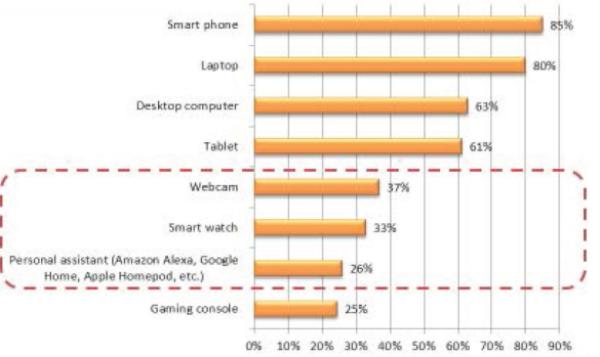29 November 2018

Which of the following devices do you own and use on campus?
The study found that compared to two years ago, there is now a “significant” number of new IoT devices used on campus networks.
Networks at higher education institutions are increasing in complexity which makes them more vulnerable to attack, according to new research by Infoblox.
For its Defending Networks at HigherLearning Institutions – Heroes Needed report, the managed network services provider surveyed 678 students, staff, and IT professionals from HE institutions in the US, UK and Germany. It revealed that 81 per cent of IT pros believe securing campus networks has become more challenging in the last two years, particularly with the increase in the number of connected devices.
For example, while two years ago students mainly brought laptops and smartphones with them to college, the average student now brings in four or more devices (see graph). In addition, 60 per cent of faculty, students and IT professionals use four or more devices on the campus which drives up network activity.
IT teams are also challenged with a high volume of turnover in students each year when one quarter or more of their users change.
Almost half of HE IT administrators believe the greatest security risks come from within the campus. For example, 54 per cent say at least a quarter of student devices come onto campus already infected with malware. Furthermore, 60 per cent of faculty and staff have not made any network security changes in the last two years, and 57 per cent use out-of-date security measures, such as updating passwords as a security precaution.
Infoblox found that lack of education on best practices is one of the major contributions to poor security hygiene amongst students and faculty staff. Thirty nine percent of IT administrators reveal that their users not being educated on security risks is one of their biggest challenges to keeping the network secure.
Beyond user error, outdated network technology poses another challenge. Seventy one per cent of students and staff revealed that their networks suffer performance issues at least once a month. Additionally, only 52 per cent of current network management solutions have DNS provisioning capabilities and can provide remote network access control.
“As higher education institutions embrace digital transformation and users become more device-reliant, their networks have become more complex and difficult to manage,” says Infoblox CTO of field engineering, Victor Danevich. “With this complexity, networks become more volatile and vulnerable to cyber attack if proper network security measures are not in place.”
The study also revealed that respondents from Germany’s HE sector were least confident in campus networks with 75 per cent noting they did not feel their personal devices were secure. That’s compared to 92 per cent in the UK. Here, respondents have the most trust in their students taking precautions to secure their sensitive data with 75 per cent trusting students. Meanwhile, only 47 per cent of those in the US felt the students were taking necessary steps.










